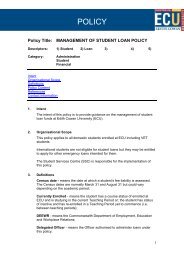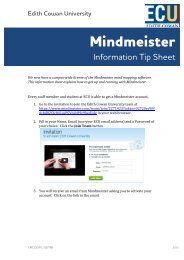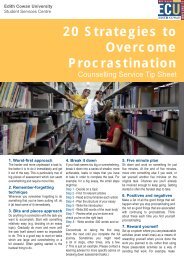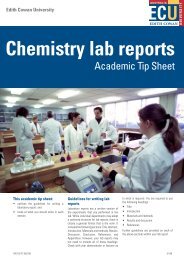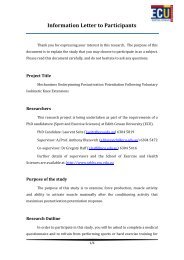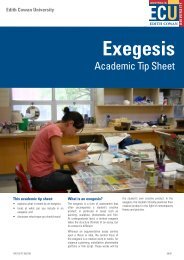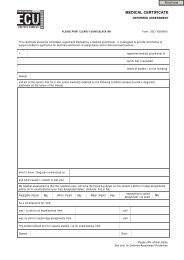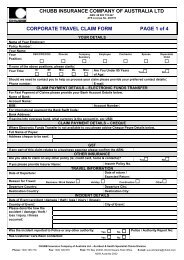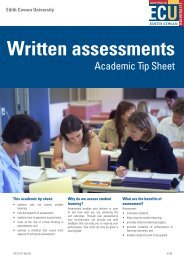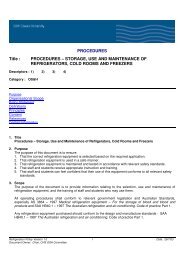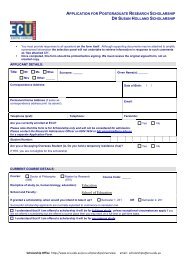Research paper - Edith Cowan University
Research paper - Edith Cowan University
Research paper - Edith Cowan University
You also want an ePaper? Increase the reach of your titles
YUMPU automatically turns print PDFs into web optimized ePapers that Google loves.
<strong>Edith</strong> <strong>Cowan</strong> <strong>University</strong><strong>Research</strong> <strong>paper</strong>Academic Tip SheetThis academic tip sheet:• explains what a research <strong>paper</strong> is;• outlines what is expected in a research<strong>paper</strong>; and• provides guidelines for developing eachsection within a research <strong>paper</strong>.What’s a research <strong>paper</strong>?The term ‘research <strong>paper</strong>’ refers to aparticular genre of academic writing, in whichthe writer’s own interpretation, evaluation,or argument on a specific issue is givenprominence). There are some similaritiesbetween a research <strong>paper</strong> and a literaturereview; for instance both require an extensivestudy of the literature.A research <strong>paper</strong> involves surveying a field ofknowledge in order to find the best possibleinformation in that field. Such information isthen utilised to present a competent argumenton a topic. Hence a research <strong>paper</strong> requires apresentation of your own thinking backed upby others’ ideas and information.In short, a research <strong>paper</strong> is:• focused on a specific issue/problem;• a presentation of facts that are basedupon extensive reading and extraction ofinformation from several sources; and• original in selection of literature,evaluation, expression and conclusion.CRICOS IPC 00279B 01/08
What is in a research <strong>paper</strong>?When writing a research <strong>paper</strong>, you areexpected to:• identify and briefly describe the works youhave consulted;• analyse and interpret relevant literature;• frame the literature as evidence to supportyour argument; and• make conclusions.This may be achieved by:• defining and clarifying the ‘problem’;• summarising previous studies to inform thereader of the state of current knowledge;• identifying agreements and disagreementsin the literature, examining contradictions,inconsistencies and gaps in the literature;• drawing conclusions based upon youranalysis; and• suggesting the next step/s towards solvingthe ‘problem’.Organising a research <strong>paper</strong>The following structure is recommended whenwriting a research <strong>paper</strong>.• Title page.• Contents page.• Abstract.• Introduction.• Discussion (this section may be furtherorganised into subheadings if the <strong>paper</strong> isextended in length).• Reference list.Structural guidelines1. The abstract• Describe the topic (in one sentence).• State the purpose/thesis/organisingconstruct of the <strong>paper</strong>.• Outline the scope of the <strong>paper</strong>.• Identify the key sources of evidence thatsubstantiates the argument (i.e., publishedliterature).• State the key conclusions.2. The introduction• Introduce the specific ‘problem’ understudy.• Summarise relevant arguments and datato give the reader a firm sense of the issue(in a couple of sentences).• Develop the background.- Discuss the literature without giving adetailed historical account.- Assume the reader is knowledgeableabout the field.- Cite only works that have directrelevance to the topic.- Demonstrate a logical continuitybetween earlier and current work (thishelps to develop breadth and scope ofyour work).- Note controversial issues whereapplicable (treat opposing viewpointsfairly).- State the purpose and rationale(i.e., your approach to solving the‘problem’).- Define the variables and state yourthesis).3. The discussion• Organise the subheadings to reflecttheoretical relationships (i.e., grouprelated ideas together).• Under each subheading summarise andsynthesise relevant information from theliterature.• Analyse and discuss (evaluate andinterpret) the information.• Consider the implications in terms of yourthesis (i.e., support vs non support for yourposition on the issue).• Based on conclusions you make, considerinferences that may be drawn (whereapplicable).• Acknowledge limitations and addressalternative explanations.• To conclude, comment on the importanceof your findings.4. The references• Ensure technical correctness in all citationsand reference list entries as per the APAreferencing system conventions.• Proofread carefully to avoid plagiarismand technical errors.Common difficultiesThe most common difficulties experienced bystudents include:• failure to research the general topic beforedeciding on a thesis statement;• failure to construct an appropriate thesisstatement;• failure to provide a connection between thethesis statement and the topic sentencesin the <strong>paper</strong>;• failure to support the <strong>paper</strong> with adequateinformation that is relevant to the specificfocus of the <strong>paper</strong>; and• failure to correctly cite all sources.How to avoid common difficultiesCarefully read the assessment instructions andguidelines. Then preview relevant literature todevelop an overall understanding of the topic.Use this basic knowledge to construct yourargument/thesis; exercise caution to ensurethat your thesis statement is neither toobroad nor too narrow to effectively enable youto fulfil the assessment requirements (e.g.,length of the <strong>paper</strong>).Develop a working thesis statement, andrevise this to improve clarity and specificity asyour <strong>paper</strong> begins to take shape. Your thesisstatement should be sufficiently compellingto persuade the reader to a particular pointof view if you are adopting an argumentativeapproach, or clearly express the gist of yourposition if you are adopting an informativeapproach within your <strong>paper</strong>.It is also important to provide adequateand relevant support for the assertions youmake within your research <strong>paper</strong> as thiswill strengthen your argument. You shouldinsert research findings that are appropriateto specific points you make, throughout the<strong>paper</strong>, rather than simply providing overallsummaries of sources (or inserting referencesthat are weakly integrated).<strong>Research</strong> <strong>paper</strong> checklist• Have you read your assessmentinstructions and guidelines?• Have you reviewed the relevantliterature to develop an overallunderstanding of the topic?• Have you used this basic knowledgeto construct your argument/thesis?• Have you developed a working thesisstatement?• Have you strengthened your argumentby providing adequate and relevantsupport for your arguments?• Have you submitted your research<strong>paper</strong> on time and in the correctformat?• Have you kept a copy of your research<strong>paper</strong>?ReferencesMarkman, R. H., Markman, P. T., & Waddell,M. L. (2001). 10 Steps in writing theresearch <strong>paper</strong> (6th ed.). Long Beach,CA: Barons.Rozakis, L. E. (1999). Writing great research<strong>paper</strong>s. San Francisco: MacGraw-HillProfessional.Sorenson, S. (2002). How to write research<strong>paper</strong>s (3rd ed.). Sydney: Thompson.Winkler, A. C. & MacCuen, J. R. (2003).Writing the research <strong>paper</strong>: Ahandbook. New York: ThomasWadsworth.AcknowledgementsThis material was modified from sourcedocuments prepared by Kuki Singh, ECU, 2007.Editor: Trevor Bennett.



